Little is known about the Central American twig anole, but it does have a beautiful dewlap! In recent years, what used to be known as A. pentaprion has been split into a large number of species, the most recently described of which is A. triumphalis. (Editor’s note: Gunther Kohler points out that this is one of the newly named species, A. charlesmyersi).
Here’s the backstory from the videographer who posted this on Youtube: Greetings Casa Alta Vista, Costa Rica. That video was shot about 15 feet above ground, on the guava wood handrail that goes up my stairs. Our house is a rustic style “pole” house, constructed from plantation grown gmelina and teak woods. We are located about 2 miles inland of the shores of Golfo Dulce , Costa Rica, at about 600 feet elev. in a mostly second growth seasonally dry rainforest. Dry season from Dec to April, then usually 300 inches of rain , a lot of which is in September-October usually. We are across the gulf from Corcovado National Park . Maybe 15 miles as the toucan flies. The area around the house was pasture up until about 20 years ago, but now pretty lush with second growth. Fairly undeveloped, and there is some primary growth surrounding us down in the “quebradas” or streams that are all around here. Down there we have stream anoles, and lots of snakes and critters. Saw a bushmaster down there once . Yikes. We also see slender anoles (I think) but they aren’t very “brown” and the yellow spot on the dewlap isn’t as prominent as the picture in my book . We also sometimes see the dry forest anole, which seems to trade off the territory of my deck railing system with the lichen anoles. We see green anoles down on some of the fruit trees we have planted as well. Amazing creatures all, they don’t seem fearful of us, and maintain eye contact . And will bite of course if they are provoked and can catch hold of you. I once had a full grown basilisk lizard that I was rescuing from some dogs bite me nicely on the hand. We have really a lot of all kinds of wildlife here. The birding is great, and we have a large troop of mono titi’s (squirrel monkeys) that occasionally traverse our back deck, peek in the windows, and move on to eat guabo beans in the trees surrounding our house. We’re built about 4 meters off the ground, not a treehouse , but kind of up in the trees .
My camera is new, and I will be posting other animal videos soon. And will try to get more anole videos.
Editor’s Update, 2/23/2015:
Here’s another clip of the same animal:















